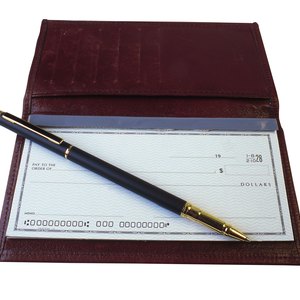
Even though most personal finance transactions will soon be completed digitally, paper checks will still be around for years to come. You might get one from an employer, a customer or client, a government agency (like your IRS tax refund) or a friend or family member.
You can deposit a check into your account at an ATM, by visiting a local bank branch, sending it through the mail or by using a digital banking app.
Read More: What Does Less Cash Mean in a Deposit Check?
Depositing at a Bank
You can deposit a check in person at a branch of the bank where you have your account. If you have a checking or savings account, you’ll need to use a deposit slip and endorse the back of the check. For extra security, you can write “For Deposit Only” under your signature and your account number on the back of check directly underneath these words. If you lose your check before you deposit it, no one can cash it – they can only deposit it.
If you use one of the deposit slips you received when you opened your account, it will have your account number on the slip. If you don’t have a deposit slip with you, you can use counter deposit slips, writing your account number on deposit slips. If you don’t know your account number, a bank teller can help you, filling out the deposit slip after you’ve provided enough identification. If you have your account debit card and a driver’s license with you, those should be enough for ID.
Fill out the deposit slip by entering the amount of cash (if any) you’re depositing along with your check. List checks separately on the slip, by each check’s amount if you’re depositing more than one check. If you want money back after you deposit your checks, write the amount of cash back you want on the “less cash” line on the deposit slip.
Finding Your Account Number
If you are depositing one of your own checks (for example, from your checking account) into another one of your accounts (such as a savings account), you can find your checking account number on the front of your check.
It will be the second set of numbers on the bottom of the check. The first set of numbers is the bank’s routing number. Your checking account number is usually followed by a space or non-numeric symbol, then two or more numbers that match your check number at the top, right-hand side of the check.
Using an ATM
You can deposit a check using an automated teller machine. You won’t need to enter your bank account number because you’ll use a debit or bank card to use the ATM and that has your account number. Insert your card into the ATM and follow the directions. You’ll be asked what type of transaction you want to perform (choose “Make a deposit”). Follow the next set of directions, which includes inserting your signed (endorsed) checks and verifying that the amount is correct after the machine scans your checks.
Using a Digital App
You can use your mobile phone or computer to deposit checks. You’ll need to be able to take a picture of the front and back of your signed check so the app or computer can scan it.
Follow the rest of the steps, which include verifying the amount and the account you want to deposit the check into. Your account number will be identified when you log in to your account via your phone or computer.
Read More: How to Deposit Checks by Mail
Mailing It In
You can deposit a check by mailing it to your bank. You’ll need a deposit slip, the signed check and an envelope and stamp. Follow the directions provided at your bank’s website or call the customer service number on your account card or monthly statement for help. The process for filling out a deposit slip is the same as if you are doing it in person. Make sure you endorse your check properly.
References
Tips
- Instead of putting a signature on the back of the check, write "Deposit Only," providing the account in which it is deposited belongs to the person to whom the check is written. The bank may require a signature on some types of checks.
Writer Bio
Steve Milano has written more than 1,000 pieces of personal finance and frugal living articles for dozens of websites, including Motley Fool, Zacks, Bankrate, Quickbooks, SmartyCents, Knew Money, Don't Waste Your Money and Credit Card Ideas, as well as his own websites.

